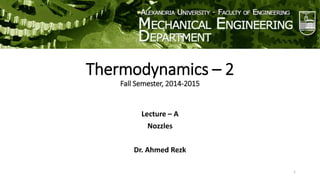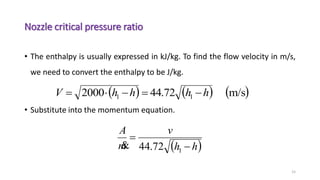Nozzles - Lecture A
- 1. Thermodynamics â 2 Fall Semester, 2014-2015 Lecture â A Nozzles Dr. Ahmed Rezk 1
- 2. Nozzles âĒ A nozzle is a device used to accelerate a flowing fluid by varying the cross-sectional area in the direction of flow. The fluid acceleration comes on the account of a pressure drop along the nozzle. âĒ Nozzles applications âĒ Steam and gas turbine âĒ Rocket engines âĒ Jet engines 2
- 3. Governing equations âĒ Steady flow continuity equation âĒ Where m is the mass flow rate at inlet section (in), outlet section (out) and any section (x) along nozzle passage. The mass flow rate can be determined as: 3 Constantï―mïĶ xoutin mmm ïĶïĶïĶ ï―ï― mïĶ
- 4. Governing equations âĒ Ï is the flowing fluid density (kg/m3) âĒ V is the velocity normal to the flow area (m/s) âĒ A the cross-sectional area (m2) âĒ Æē fluid specific volume (m3/kg) 4 ïĻ ïĐskg v AV AVm /ï―ï― ïēïĶ x xx out outout in inin v VA v VA v VA ï―ï―
- 5. Governing equations âĒ Steady flow energy equation (per unit mass) âĒ Apply the following assumption: âĒ Negligible heat losses (adiabatic). âĒ No work done on or by the system. âĒ The nozzle passage is very small and hence the change in the potential energy is negligible even in vertical nozzle. 5 ïĻ ïĐ ïĻ ïĐinout inout inout zzg VV hhwq ïïïŦï· ï· ïļ ïķ ï§ ï§ ïĻ ïĶ ï ïŦïï―ï 2 22
- 6. Governing equations âĒ The steady flow energy equation can be describe as: âĒ Applying the steady flow energy equation between section 1 and any section X along the fluid flow along the nozzle passage. 6 outin inout hh VV ïï― ï 2 22 ïĻ ïĐXX hhVV ïïïŦï― 1 2 1 2 2 ïĻ ïĐXX hhVV ïïïŦï― 1 2 1 2
- 7. Nozzle shape âĒ This part is to find the change in the nozzle cross-sectional area to increase the fluid flow velocity to the required value. âĒ Consider a stream of fluid flow of inlet pressure and enthalpy of Pin and hin. Assume the inlet velocity (Vin) is very small. Now describe the change of the nozzle area to increase the fluid velocity. âĒ Apply the steady state momentum equation and replace the velocity with the corresponding term from energy equation, and hence: 7
- 8. Nozzle shape âĒ The relation between the initial and final thermo-physical properties depends on the thermodynamic process. âĒ Assume frictionless fluid flow + adiabatic flow = reversible adiabatic (isentropic) process. âĒ At any section X, sx=s1=constant. 8 ïĻ ïĐX XX hhV v m A ïïïŦ ï― 1 2 1 2ïĶ X XX v VA m ï―ïĶ X XX V v m A ï― ïĶ
- 9. Nozzle shape âĒ At any section, by knowing the pressure and constant entropy, other parameters can be determined. 9
- 10. Nozzle shape âĒ The following graph presents the effect of reducing gas pressure and the influence on the cross-sectional area and flow velocity. 10 âĒ It is observed that the area decreases initially, hit the minimum at certain point then increases again. âĒ The area decreases, when v-j increases less rapidly than V-jj. âĒ The area increases, when v-jj increases more rapidly than V-j. X XX V v m A ï― ïĶ
- 11. Nozzle shape (case study) 11 020406080100 FlowPressure (kPa) Area Velocity
- 12. Nozzle shape âĒ Based on the aforementioned information. That type of nozzle is called a convergent-divergent nozzle (the following graph). 12
- 13. Nozzle shape âĒ The section of minimum area is called the throat of the nozzle. âĒ The velocity at the throat of a nozzle operating at its designed pressure ratio is the velocity of sound at the throat conditions. âĒ The flow up to the throat is sub-sonic; the flow after the throat is supersonic 13 âĒ The specific volume of a liquid is constant over a wide pressure range, and therefore nozzles for liquids are always convergent.
- 14. Nozzle critical pressure ratio âĒ You can design a convergent divergent nozzle where the velocity at the nozzle through equal the sound velocity. âĒ The ratio of the pressure at the section of sonic velocity to the pressure at nozzle inlet is called the critical pressure ratio Z c. âĒ Solve the energy and momentum equations between the inlet section and any point along the nozzle passage. âĒ In most practical applications the inlet velocity is negligible, so the energy equation can be reduced to. 14 ïĻ ïĐhhV ïïï― 12ïĻ ïĐhhVV ïïïŦï― 1 2 1 2
- 15. Nozzle critical pressure ratio âĒ The enthalpy is usually expressed in kJ/kg. To find the flow velocity in m/s, we need to convert the enthalpy to be J/kg. âĒ Substitute into the momentum equation. 15 ïĻ ïĐ ïĻ ïĐ ïĻ ïĐm/s72.442000 11 hhhhV ïï―ïïï― ïĻ ïĐhh v m A ï ï― 172.44ïĶ
- 16. Nozzle critical pressure ratio âĒ Apply for perfect gas (constant specific heats). âĒ For isentropic process. 16 ïĻ ïĐ ïĻ ïĐ ï·ï· ïļ ïķ ï§ï§ ïĻ ïĶ ïïï ï― ïï ï― ï ï― 1 1 11 172.44 72.4472.44 T T TCp v TTCp v hh v m A ïĶ ï·ï· ïļ ïķ ï§ï§ ïĻ ïĶ ï ï·ï· ïļ ïķ ï§ï§ ïĻ ïĶ ï― ï§ ï§ 1 11 P P T T RTPv ï― P RT v ï―
- 17. Nozzle critical pressure ratio âĒ Let the pressure ratio (z) 17 1P P z ï― ïĻ ïĐï§ï§ ï§ï§ 1 11 1 1 172.44 ï ï ïïïïïï ïï ï― zTCpPz zTR m A ïĶ ïĻ ïĐ ïĻ ïĐ ïĻ ïĐ ïĻ ïĐï§ï§ï§ï§ï§ï§ï§ï§ï§ï§ï§ï§ï§ 121221211 constantconstant 1 constant 1 constant ïŦïïï ï ï― ïï ï― ïï ï― ï ï― zzzzzzzzzm A ïĶ
- 18. Nozzle critical pressure ratio âĒ To find the value of pressure ratio zc, at which the area per mass flow is minimum, the differentiation of that term should be equal to zero. 18 ïĻ ïĐ 0 constant 12 ï― ïš ïš ïŧ ïđ ïŠ ïŠ ïŦ ïĐ ï ïŦ ï§ï§ï§ zzdz d 1 1 1 2 RatioPressureCritical ï ï·ï· ïļ ïķ ï§ï§ ïĻ ïĶ ïŦ ï―ï―ï― ï§ ï§ ï§P P z c c
- 19. Critical temperature ratio âĒ The ratio of temperature at the section where the sonic velocity is attained to the inlet temperature is called the critical temperature ratio. 19 1 2 RatioeTemperaturCritical 1 11 ïŦ ï―ï·ï· ïļ ïķ ï§ï§ ïĻ ïĶ ï―ï― ï ï§ ï§ ï§ P P T T cc
- 20. Critical Velocity âĒ To find the critical velocity 20 ïĻ ïĐ ï· ïļ ïķ ï§ ïĻ ïĶ ïïïïï―ïïïï― 122 1 1 T T TCpTTCpVï ïĻ ïĐ ccc c cc TRTCpTCp T T TCpV ïïï―ïïïï―ï· ïļ ïķ ï§ ïĻ ïĶ ï ïŦ ïïïï―ï·ï· ïļ ïķ ï§ï§ ïĻ ïĶ ïïïïï―ï ï§ï§ ï§ 11 2 1 212 1
- 21. Example âĒ Air at 8.6 bar and 190°C expands at a rate of 4.5 kg/s through a convergent divergent nozzle into a space at 1.03 bar. Assuming that the inlet velocity is negligible. Determine the through and the exit cross-sectional area of the nozzle. 21
- 22. Example âĒ The critical pressure, temperature, velocity and area = through area. 22 528.0 1 2 1 1 ï―ï·ï· ïļ ïķ ï§ï§ ïĻ ïĶ ïŦ ï― ïï§ ï§ ï§P Pc KTTc 8.385 1 2 1 ï―ï ïŦ ï― ï§ )/(244.0 3 kgm P RT v c c c ï―ï― ïĻ ïĐ ïĻ ïĐsm smTRV cc /343SpeedSonic /394 ï― ï―ïïï― ï§ c cc v VA m ï―ïĶ ïĻ ïĐ2 00279.0 m V vm A c c c ï― ï ï― ïĶ





















